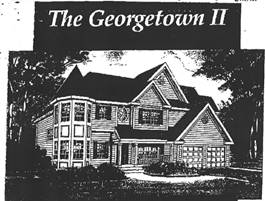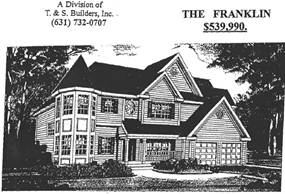
June 2013 Issue
Copyright Cases
Axelrod & Cherveny Architects P.C. v. T. & S. Builders Inc.,
2013 WL 1856655 (E.D.N.Y. May 2, 2013)
CASE SUMMARY
FACTS
A group of architects accused a home builder of infringing their copyrights by constructing homes in New York that, at least from the exterior, looked substantially similar to the architects’ designs. The architects owned copyrighted designs known as the “Georgetown II.” The home builder marketed four homes on Long Island under the model name “the Franklin.”


The architects’ Georgetown II was marketed with a brochure that contained an artist’s rendering of the home’s exterior as well as the interior floor plan. The brochure itself was not copyrighted. The home builder’s sales literature contained a copy of the first page of the architects’ Georgetown II brochure and displayed the Georgetown II’s exterior. Some of the home builder’s flyers also included floor plans identical or nearly identical to the Georgetown II floor plans.
A field supervisor for the home builder testified during his deposition that it was common practice in the construction industry to obtain brochures from competitors and to use them for reference—not to actually copy a competitor’s model. He also testified that, despite the images on the home builder’s sales literature, the Franklin homes were “substantially different” due to options requested by the buyers.ANALYSIS
In an August 2013 order, the court reviewed the two elements necessary to establish copyright infringement: (1) ownership of a valid copyright; and (2) unauthorized copying of the copyrighted work. Only the second element was at issue because the parties did not dispute that the architects had a valid copyright. To prove the second element, the court first looked at the questions of access and substantial similarity between the two homes. The court found the architects had direct evidence of copying because the home builder used Georgetown II sales literature in its advertising for the Franklin. Therefore, the court stated, summary judgment turned on whether the home builder’s copying qualified as actionable copyright infringement, namely, whether there was substantial similarity between the Franklin and the protectable elements of the Georgetown II.
The court ordered supplemental briefing from the parties on two issues: (1) whether the home builder’s act of copying the Georgetown II’s exterior with substantial modifications to the interior could constitute infringement, given that case law instructs substantial similarity must be determined by the work as a whole; and (2) whether the home builder’s use of the architects’ sales brochures in and of itself constituted an act of copyright infringement.
In its May 2013 ruling, the court first explained that although the Second Circuit had never addressed whether infringement can be established on just the copying of a building’s exterior, courts outside the circuit had found infringement (citing to federal district courts in the Western District of Virginia and Western District of North Carolina). “The underlying rationale for this legal proposition, which has also been applied by the Second Circuit in other contexts, is that ‘[i]t is not necessary to prove that every element of the [floor] plans or structure was copied; it is sufficient to show that a substantial portion was copied.’” Finding this rationale persuasive, the court determined that, even if evidence at trial demonstrated that the interiors of the Franklin homes as constructed were not substantially similar to the interior of the Georgetown II, the substantial similarity of the exterior designs was enough to grant the architects summary judgment on infringement.
The court next determined that the copying of floor plans from the Georgetown II brochure was also copyright infringement. Although the Georgetown II brochure was not copyrighted, the floor plans contained in the brochures were. Therefore, the court concluded, copying floor plans from the Georgetown II brochure for use in the home builder’s advertisements for homes with substantially similar designs constituted infringement. The home builder argued that it used material in the brochures only to depict the general appearance of the Franklin and that the interiors as actually constructed did not reflect the images in the brochures. The home builders, however, did not explain how any purported modifications during construction absolved them of liability for using the floor plans on its sales brochures. CONCLUSION
This decision, within the influential Second Circuit, expands the number of federal courts that have found a copyright-infringement action can succeed based solely on the copying of the exterior of an architectural design.